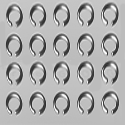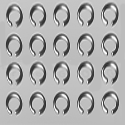Proactive metamaterials
When fabricated with structural patterning such as holes or twists, normal materials can acquire completely new electromagnetic properties, including perfect focusing (superlensing) and cloaking. These “metamaterials” are generally constructed from passive metals and insulators, deriving their unusual properties from structure rather than intrinsic composition. But as Alexander Katko, Shi Gu, John P. Barrett, Bogdan-Ioan Popa, and Steven Cummer of Duke University, and Gennady Shvets of the University of Texas at Austin, both in the US, report in Physical Review Letters, an entirely new set of possibilities emerges when metamaterials are made from active nonlinear elements whose inherent properties can be adjusted by external control or react dynamically to incident fields.
One basic building block of metamaterials is the split-ring resonator (SRR), a pair of notched annular metal rings. These are then assembled in 2D or 3D arrays to create the structured material with desired properties. Katko et al. combine the split in the ring with varactor diodes, which act as a combination of a diode and a voltage-controlled capacitor. Calculations predict, and experiments confirm, that an array of SRRs incorporating these nonlinear circuit elements will produce phase conjugation, in which an incoming microwave signal is converted into its time-reversed mirror image. Such effects can be used to correct wave fronts that propagate through distorting media. The authors propose that such active nonlinear metamaterials will find use in rf imaging much like superlensing with negative refractive index materials. – David Voss





